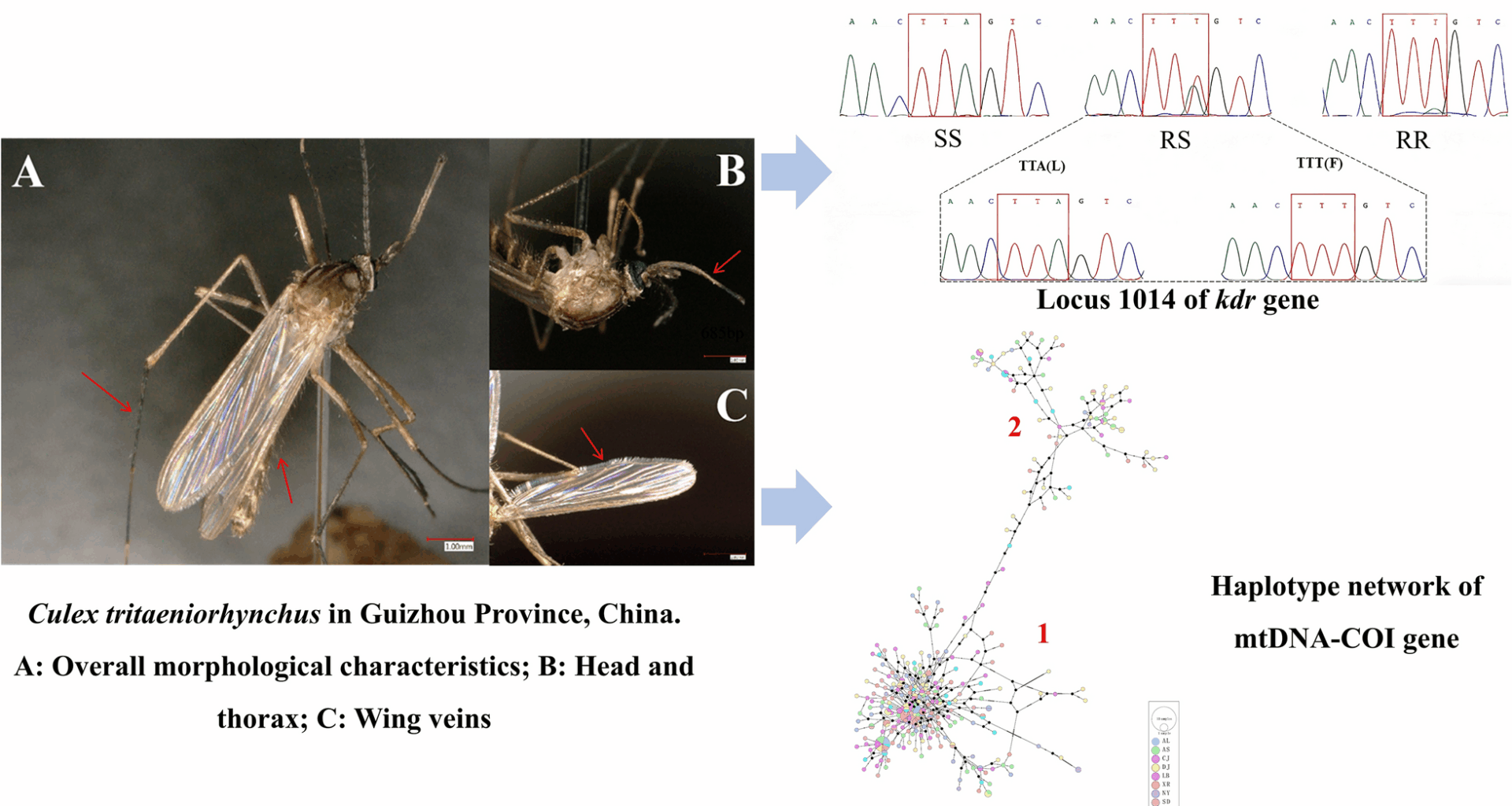Insecticide resistance reflects adaptive evolutionary dynamics, where selective pressure favors the survival and proliferation of resistant genotypes, where sensitive individuals are gradually eliminated under the continuous action of insecticides, and resistance genes accumulate in populations through natural selection and spread to other regions with the migration of individuals [16]. Therefore, in this study, we examined the resistance genes and mtDNA–COI genes and analyzed the population genetic structure of Culex tritaeniorhynchus in Guizhou Province, to inform surveillance strategies and guide regional vector control interventions in Guizhou Province.
In this study, mtDNA–COI sequences (n = 365) were obtained for all specimens in which the kdr gene was successfully detected. mtDNA–COIs were examined and a total of 267 haplotypes were identified. Similar to some previous studies, Culex tritaeniorhynchus populations in Guizhou Province showed high haplotype diversity and low nucleotide diversity [17, 18]. High haplotypic diversity coupled with low nucleotide diversity suggests a young, expansive population undergoing rapid ecological adaptation. Some researchers have suggested that this environmental condition conducive to vector proliferation for mosquito survival and dispersal in tropical/subtropical regions contributes to this phenomenon [19, 20]. The high genetic diversity helps insects accumulate ecologically adapted advantageous genes and acquire mutations favoring resistance more rapidly in each generation, exacerbating the risk of insect-borne disease transmission [21].
Meanwhile, the results of genetic differentiation coefficient (Fst = 0.001–0.140) and gene flow (Nm > 1) among Culex tritaeniorhynchus populations in different regions of Guizhou indicated that most populations are not genetically isolated. It is also consistent with the genetic exchange of populations between other regions in mainland China [22]. This situation may be related to a variety of factors. Guizhou Province has a well-developed tourism industry, and frequent human activities and increased tourist activities may provide vectors for mosquitoes to migrate across regions [23]. The larvae and eggs of Culex tritaeniorhynchus may be dispersed downstream with water currents or may be transmitted over long distances by vectors such as boats [24]. Anthropogenic and hydrological factors likely contribute to the spatial dispersal and genetic homogenization of regional populations. In addition, this may also be related to the flight ability of Culex tritaeniorhynchus adult mosquitoes, which has been found to be able to migrate long distances relying on the monsoon and even able to transoceanic dispersal between different countries in East Asia, thus contributing to the rich genetic exchange of Culex tritaeniorhynchus populations between different regions and countries [25, 26]. This capacity for long-distance dispersal via prevailing winds has critical implications for cross-border resistance management. Although the mutation frequency of Culex tritaeniorhynchus kdr gene in Guizhou Province is currently at a low level, it needs continuous attention because of its frequent gene exchange and the ease of spreading the resistance gene to different regions after its formation.
Haplotype networks and phylogenetic trees were constructed on the basis of the mtDNA–COI gene, and the results of the two methods basically coincided, both indicating that the Culex tritaeniorhynchus population in Guizhou Province was divided into two groups. This genealogical pattern is widespread in China, Korea, and Japan, and has been suggested by some researchers to indicate the presence of possible cryptic or novel species in Culex tritaeniorhynchus [17, 22, 26]. These findings align with emerging evidence of cryptic speciation within Culex tritaeniorhynchus, though further morphometric and genomic analyses are required. In addition, at the regional level in Guizhou Province, different regions did not show significant clustering, further supporting the ability of Culex tritaeniorhynchus to exchange genes across regions.
The kdr allele gene frequency of Culex tritaeniorhynchus in Guizhou Province was low overall (0–8.8%), much lower than that of Culex tritaeniorhynchus in the neighboring region of Sichuan Province (17.0–27.8%), and also lower than that of the rest of China (10–29.6%) [10, 27]. Mosquito resistance to insecticides arises through a variety of mechanisms, including metabolic resistance, epidermal resistance, behavioral resistance, and target resistance [28]. Mutations in the target locus render the insecticide ineffective for binding or less potent, thus reducing its killing effect [29]. The kdr gene detected in this study is also one of the target loci, and some studies have shown that there is a positive correlation between pyrethroid resistance and kdr mutation frequency. This indicates that Culex tritaeniorhynchus populations in Guizhou Province have not yet developed widespread resistance to pyrethroid insecticides, and effective control of Culex tritaeniorhynchus populations can still be achieved by pyrethroid insecticides at present. However, resistance studies on other mosquitoes have also shown that metabolic resistance also plays an important role in pyrethroid insecticide resistance in Anopheles sinensis in some areas of China [30]. While target-site mutations such as kdr play a clear role, integrated resistance mechanisms—including metabolic and behavioral adaptations—are likely co-contributors. This also suggests that more data are needed to clarify the pyrethroid insecticide resistance of Culex tritaeniorhynchus in Guizhou Province. At the same time, on the basis of the results of mtDNA–COI gene, owing to the rich gene exchange among populations in different regions, resistance that appears in one region may rapidly spread to other regions. Although kdr resistance is currently at a low level, given the high connectivity among populations, ongoing molecular monitoring remains critical to intercept emerging resistance patterns. Local public health departments should strengthen surveillance of insecticide resistance in Culex tritaeniorhynchus to prevent the spread of insecticide resistance.

